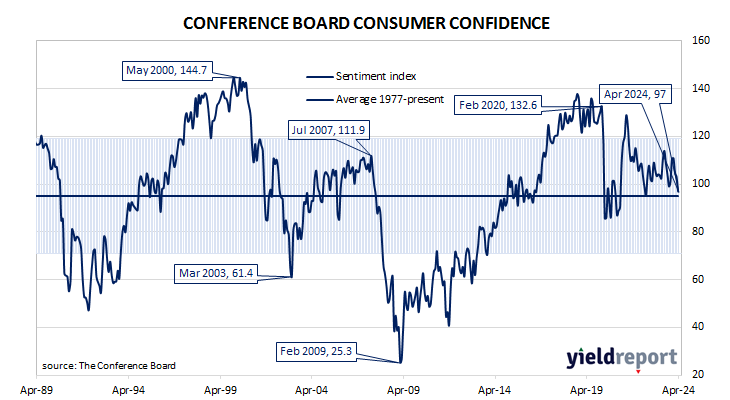Summary: Conference Board Consumer Confidence Index down in April, reading less than expected; consumers less positive about current labour market, more concerned about future business conditions, job availability, income; US Treasury yields increase; expectations of Fed rate cuts soften; confidence declined among consumers of all age groups, all income groups except for $25,000 to $49,999 bracket; views of present conditions, short-term outlook both deteriorate.
US consumer confidence clawed its way back to neutral over the five years after the GFC in 2008/2009 and then went from strength to strength until late 2018. Measures of consumer confidence then oscillated within a relatively narrow band at historically high levels until they plunged in early 2020. Subsequent readings then fluctuated around the long-term average until March 2021 when they returned to elevated levels. However, a noticeable gap has since emerged between the two most-widely followed surveys.
The latest Conference Board survey held during the first three weeks of April indicated US consumer confidence has deteriorated further. April’s Consumer Confidence Index registered 97.0 on a preliminary basis, well below the generally-expected figure of 104.1 and March’s final figure of 103.1 after it was revised from 104.7.
“Confidence retreated further in April, reaching its lowest level since July 2022 as consumers became less positive about the current labour market situation, and more concerned about future business conditions, job availability, and income,” said Dana Peterson, Chief Economist at The Conference Board.
US Treasury yields increased uniformly across the curve on the day, propelled by higher-than-expected March quarter employment cost indices. By the close of business, 2-year, 10-year and 30-year Treasury bond yields had all gained 6bps to 5.04%, 4.68% and 4.79% respectively.
In terms of US Fed policy, expectations of a lower federal funds rate in the next 12 months softened, although almost two 25bps cuts are still currently factored in. At the close of business, contracts implied the effective federal funds rate would average 5.33% in May, in line with the current spot rate, 5.315% in June and 5.305% in July. However, April 2025 contracts implied 4.89%, 44bps less than the current rate.
“In the month, confidence declined among consumers of all age groups and almost all income groups except for the $25,000 to $49,999 bracket,” Peterson added. “Nonetheless, consumers under 35 continued to express greater confidence than those over 35.”
Consumers’ views of present conditions and their views of the near-future both deteriorated. The Present Situation Index decreased from March’s revised figure of 146.8 to 142.9 while the Expectations Index moved down from 74.0 to 66.4.
The Consumer Confidence Survey is one of two widely followed monthly US consumer sentiment surveys which produce sentiment indices. The Conference Board’s index is based on perceptions of current business and employment conditions, as well as respondents’ expectations of conditions six months in the future. The other survey, conducted by the University of Michigan, is similar and it is used to produce an Index of Consumer Sentiment. That survey differs in that it does not ask respondents explicitly about their views of the labour market and it also includes some longer-term questions.



